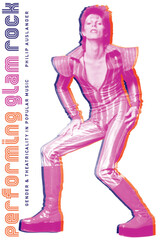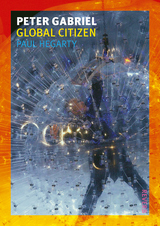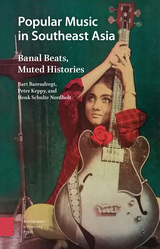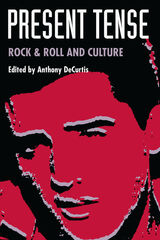108 books about Rock and 6
start with P
108 books about Rock and 6
108 books about Rock
6 start with P start with P
6 start with P start with P

Performing Glam Rock
Gender and Theatricality in Popular Music
Philip Auslander
University of Michigan Press, 2006
When it first appeared in the early 1970s, glam rock not only caused a stir among audiences and performers, it also stood counterculture and psychedelic rock on their heads. Glam rock was outrageous and overtly theatrical, and its unforgettable characters-adorned with flamboyant costumes and heavy makeup and accompanied by elaborately constructed sets-were personified by performers such as Marc Bolan, David Bowie, Bryan Ferry, and Suzi Quatro. A sea change in rock performance had occurred.
Yet glam was as much about substance as style, and Performing Glam Rock delves into the many ways glam paved the way for new explorations of identity in terms of gender, sexuality, and performance. Philip Auslander positions glam historically and examines it as a set of performance strategies, exploring the ways in which glam rock-while celebrating the showmanship of 1950s rock and roll-began to undermine rock's adherence to the ideology of authenticity in the late 1960s.
In this important study of a too-often-overlooked phenomenon, Auslander takes a fresh look at the genius of the glam movement and introduces glam to a new generation of performance enthusiasts and scholars alike.
Philip Auslander is Professor in the School of Literature, Communication, and Culture at the Georgia Institute of Technology and author of numerous books, including Liveness: Performance in a Mediatized Culture and Presence and Resistance: Postmodernism and Cultural Politics in Contemporary American Performance. He is editor of the major reference work Performance: Critical Concepts and coeditor, with Carrie Sandahl, of Bodies in Commotion: Disability and Performance.
Yet glam was as much about substance as style, and Performing Glam Rock delves into the many ways glam paved the way for new explorations of identity in terms of gender, sexuality, and performance. Philip Auslander positions glam historically and examines it as a set of performance strategies, exploring the ways in which glam rock-while celebrating the showmanship of 1950s rock and roll-began to undermine rock's adherence to the ideology of authenticity in the late 1960s.
In this important study of a too-often-overlooked phenomenon, Auslander takes a fresh look at the genius of the glam movement and introduces glam to a new generation of performance enthusiasts and scholars alike.
Philip Auslander is Professor in the School of Literature, Communication, and Culture at the Georgia Institute of Technology and author of numerous books, including Liveness: Performance in a Mediatized Culture and Presence and Resistance: Postmodernism and Cultural Politics in Contemporary American Performance. He is editor of the major reference work Performance: Critical Concepts and coeditor, with Carrie Sandahl, of Bodies in Commotion: Disability and Performance.
[more]

Peter Gabriel
Global Citizen
Paul Hegarty
Reaktion Books, 2018
Peter Gabriel is one of contemporary music’s great experimenters. From his work in the progressive group Genesis, through his pioneering solo albums, to his enthusiastic embrace of world music and new technologies, Gabriel has remained steadfast in his commitment to redefining music’s boundaries and influence—geographical, virtual, and thematic.
Peter Gabriel offers nuanced and trenchant insight into this enigmatic, questing musician and his works, into an artist whose constant traveling—through identities, influences, and media—defines him as one of modern culture’s truly global citizens. At the heart of Paul Hegarty’s analysis is the idea of locatedness: what it means to be in a specific place at a given time, and to reflect on that time and the changes which inevitably occur. Gabriel’s work, Hegarty argues, can be understood as a series of reflections on the “where” of being—a facet of existence that spans everything from politics to psychology, philosophy, psychogeography, and inward reflection.
Peter Gabriel offers nuanced and trenchant insight into this enigmatic, questing musician and his works, into an artist whose constant traveling—through identities, influences, and media—defines him as one of modern culture’s truly global citizens. At the heart of Paul Hegarty’s analysis is the idea of locatedness: what it means to be in a specific place at a given time, and to reflect on that time and the changes which inevitably occur. Gabriel’s work, Hegarty argues, can be understood as a series of reflections on the “where” of being—a facet of existence that spans everything from politics to psychology, philosophy, psychogeography, and inward reflection.
[more]

Pick Up the Pieces
Excursions in Seventies Music
John Corbett
University of Chicago Press, 2019
Unless you lived through the 1970s, it seems impossible to understand it at all. Drug delirium, groovy fashion, religious cults, mega corporations, glitzy glam, hard rock, global unrest—from our 2018 perspective, the seventies are often remembered as a bizarre blur of bohemianism and disco. With Pick Up the Pieces, John Corbett transports us back in time to this thrillingly tumultuous era through a playful exploration of its music. Song by song, album by album, he draws our imaginations back into one of the wildest decades in history.
Rock. Disco. Pop. Soul. Jazz. Folk. Funk. The music scene of the 1970s was as varied as it was exhilarating, but the decade’s diversity of sound has never been captured in one book before now. Pick Up the Pieces gives a panoramic view of the era’s music and culture through seventy-eight essays that allow readers to dip in and out of the decade at random or immerse themselves completely in Corbett’s chronological journey.
An inviting mix of skilled music criticism and cultural observation, Pick Up the Pieces is also a coming-of-age story, tracking the author’s absorption in music as he grows from age seven to seventeen. Along with entertaining personal observations and stories, Corbett includes little-known insights into musicians from Pink Floyd, Joni Mitchell, James Brown, and Fleetwood Mac to the Residents, Devo, Gal Costa, and Julius Hemphill.
A master DJ on the page, Corbett takes us through the curated playlist that is Pick Up the Pieces with captivating melody of language and powerful enthusiasm for the era. This funny, energetic book will have readers longing nostalgically for a decade long past.
Rock. Disco. Pop. Soul. Jazz. Folk. Funk. The music scene of the 1970s was as varied as it was exhilarating, but the decade’s diversity of sound has never been captured in one book before now. Pick Up the Pieces gives a panoramic view of the era’s music and culture through seventy-eight essays that allow readers to dip in and out of the decade at random or immerse themselves completely in Corbett’s chronological journey.
An inviting mix of skilled music criticism and cultural observation, Pick Up the Pieces is also a coming-of-age story, tracking the author’s absorption in music as he grows from age seven to seventeen. Along with entertaining personal observations and stories, Corbett includes little-known insights into musicians from Pink Floyd, Joni Mitchell, James Brown, and Fleetwood Mac to the Residents, Devo, Gal Costa, and Julius Hemphill.
A master DJ on the page, Corbett takes us through the curated playlist that is Pick Up the Pieces with captivating melody of language and powerful enthusiasm for the era. This funny, energetic book will have readers longing nostalgically for a decade long past.
[more]

Pin-Ups 1972
Third Generation Rock ’n’ Roll
Peter Stanfield
Reaktion Books, 2022
A sleazy, neon- and grease-stuffed chronicle of London’s rock scene during the pivotal year of 1972—from Marc Bolan to the New York Dolls.
Elvis, Eddie, Chuck, Gene, Buddy, and Little Richard were the original rockers. Dylan, the Beatles, the Stones, and the Who formed rock’s second coming. As the 1960s turned into the 1970s, the crucial question was who would lead rock ’n’ roll’s third generation?
Pin-Ups 1972 tracks the London music scene during this pivotal year, all Soho sleaze, neon, grease, and leather. It begins with the dissolution of the underground and the chart success of Marc Bolan. T. Rextasy formed the backdrop to Lou Reed and Iggy Pop’s British exile and their collaborations with David Bowie. This was the year Bowie became a star and redefined the teenage wasteland. In his wake followed Roxy Music and the New York Dolls, future-tense rock ’n’ roll revivalists. Bowie, Bolan, Iggy, Lou, Roxy, and the Dolls—pin-ups for a new generation.
Elvis, Eddie, Chuck, Gene, Buddy, and Little Richard were the original rockers. Dylan, the Beatles, the Stones, and the Who formed rock’s second coming. As the 1960s turned into the 1970s, the crucial question was who would lead rock ’n’ roll’s third generation?
Pin-Ups 1972 tracks the London music scene during this pivotal year, all Soho sleaze, neon, grease, and leather. It begins with the dissolution of the underground and the chart success of Marc Bolan. T. Rextasy formed the backdrop to Lou Reed and Iggy Pop’s British exile and their collaborations with David Bowie. This was the year Bowie became a star and redefined the teenage wasteland. In his wake followed Roxy Music and the New York Dolls, future-tense rock ’n’ roll revivalists. Bowie, Bolan, Iggy, Lou, Roxy, and the Dolls—pin-ups for a new generation.
[more]

Popular Music in Southeast Asia
Banal Beats, Muted Histories
Bart Barentdregt, Peter Keppy, and Henk Schulte Nordholt
Amsterdam University Press, 2017
From the 1920s on, popular music in Southeast Asia was a mass-audience phenomenon that drew new connections between indigenous musical styles and contemporary genres from elsewhere to create new, hybrid forms. This book presents a cultural history of modern Southeast Asia from the vantage point of popular music, considering not just singers and musicians but their fans as well, showing how the music was intrinsically bound up with modern life and the societal changes that came with it. Reaching new audiences across national borders, popular music of the period helped push social change, and at times served as a medium for expressions of social or political discontent.
[more]

Present Tense
Rock & Roll and Culture
Anthony DeCurtis, ed.
Duke University Press, 1992
The most compelling art form to emerge from the United States in the second half of the twentieth century, rock & roll stands in an edgy relationship with its own mythology, its own musicological history and the broader culture in which it plays a part. In Present Tense, Anthony DeCurtis brings together writers from a wide variety of fields to explore how rock & roll is made, consumed, and experienced in our time.
In this collection, Greil Marcus creates a collage of words and pictures that evokes and explores Elvis Presley's grisly fate as an American cultural image, while Robert Palmer tells the gripping tale of the origins and meanings of the electric guitar. Rap music, MTV, and the issue of gender identity in the work of Bruce Springsteen all undergo thorough examination; rock & roll's complex relationship with the forces of censorship gets a remarkably fresh reading; and the mainstreaming of rock & roll in the 1980s is detailed and analyzed. And, in an interview with Laurie Anderson and an essay by Atlanta musician Jeff Calder, the artists speak for themselves.
Contributors. Jeff Calder, Anthony DeCurtis, Mark Dery, Paul Evans, Glenn Gass, Trent Hill, Michael Jarrett, Alan Light, Greil Marcus, Robert Palmer, Robert B. Ray, Dan Rubey, David R. Shumway, Martha Nell Smith, Paul Smith
In this collection, Greil Marcus creates a collage of words and pictures that evokes and explores Elvis Presley's grisly fate as an American cultural image, while Robert Palmer tells the gripping tale of the origins and meanings of the electric guitar. Rap music, MTV, and the issue of gender identity in the work of Bruce Springsteen all undergo thorough examination; rock & roll's complex relationship with the forces of censorship gets a remarkably fresh reading; and the mainstreaming of rock & roll in the 1980s is detailed and analyzed. And, in an interview with Laurie Anderson and an essay by Atlanta musician Jeff Calder, the artists speak for themselves.
Contributors. Jeff Calder, Anthony DeCurtis, Mark Dery, Paul Evans, Glenn Gass, Trent Hill, Michael Jarrett, Alan Light, Greil Marcus, Robert Palmer, Robert B. Ray, Dan Rubey, David R. Shumway, Martha Nell Smith, Paul Smith
[more]
READERS
Browse our collection.
PUBLISHERS
See BiblioVault's publisher services.
STUDENT SERVICES
Files for college accessibility offices.
UChicago Accessibility Resources
home | accessibility | search | about | contact us
BiblioVault ® 2001 - 2024
The University of Chicago Press









